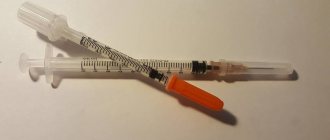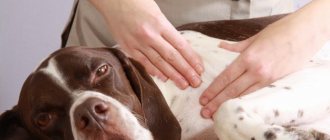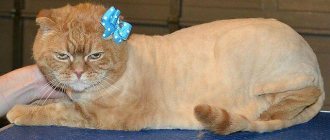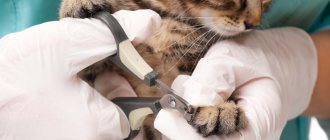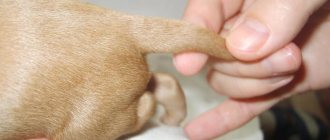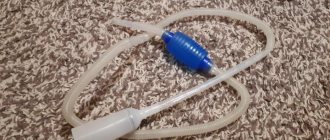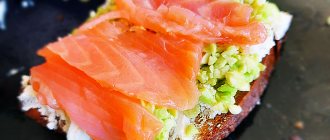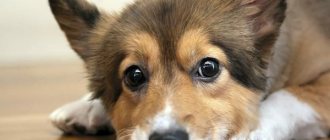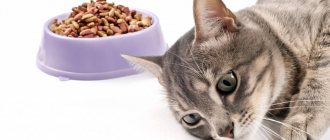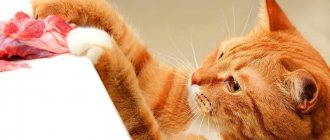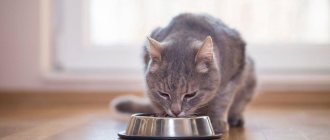Few owners of furry pets know how to properly massage a cat with constipation. Usually this problem is treated with medications or folk remedies, the simplest of which are the use of petroleum jelly or linseed oil. It is worth knowing that massaging the abdominal area provides quick relief. But to get the best results, you need to be able to do it correctly.
General information
Constipation is considered a serious deviation for cats, in which it is difficult to pass feces or their absolute absence. Massaging a kitten's belly is only allowed if there are no contraindications. In an adult, constipation is considered the inability to go to the toilet for more than 3 days, while the feces become hard and dry, which causes pain when pushing. The following reasons cause a similar problem in cats:
- fatty and poor quality diet;
- tumors and inflammation in the gastrointestinal tract;
- disorders of the kidneys and liver;
- prostatitis in a special male;
- narrowed anus;
- foreign body in the body;
- disorders of the musculoskeletal system;
- inguinal hernias;
- taking medications.
Constipation cannot be called an independent disease; it is rather a symptom of various pathologies. For this reason, in order to completely eliminate defecation difficulties, it is recommended to initially eliminate the causes of the occurrence.
Causes of constipation
The most common cause, depending on the owner, is an unbalanced diet. For normal digestion and bowel movements, the cat must receive foods with hard fibers. Inexperienced owners often believe that if they feed their pet only meat, it will be healthier. In fact, exclusively protein foods quickly lead to stagnation in the intestines.
Cats are nocturnal hunters, feeding in the wild only on what they catch. The cat eats its prey along with its fur, intestines and its contents. With a natural diet, the ratio of protein to fiber is approximately 10:1–10:2.
Important! If a cat receives an unbalanced diet, in which carbohydrate foods predominate over protein foods, it may also develop constipation.
Constipation can occur due to blockage of the small or large intestine. Due to the cat's curiosity, it may eat something inedible , for example, a piece of rope, Christmas tree decorations, wrapping paper or cellophane. An equally common cause of constipation is excess weight. If an animal is obese, metabolic processes are disrupted, which can lead to the formation of dry feces.
Preparation
For massage, it is recommended to choose a neutral time: give the kitten a rest after eating and do not distract him from playing.
Before the massage, kittens are recommended to prepare, for which you will need:
- Find the right time. You can do any manipulations with your pet only when the cat is not busy with anything. You should not touch her immediately after feeding, when licking her fur, or when playing.
- Pet the cat. It is advisable to pet, talk to the animal, and calm it down.
- Choose a place for a massage. It is recommended to do the procedure on the owner’s lap; options for a sofa or chair are possible.
Methodology
Many veterinarians recommend massage as an adjunct to drug treatment.
For constipation, the following methods of treatment are used:
- stroking;
- trituration;
- kneading;
- vibration.
However, there is no universal method for how to massage a cat with constipation. You need to observe the cat’s behavior and reaction and adjust actions depending on this.
All movements are carried out with little effort so as not to harm the animal. Use your palms or fingertips. Actions should not cause pain.
The physiotherapy procedure involves several stages.
Preparation
The owner himself must set himself in a calm mood and adjust the cat. There shouldn't be any nervousness. The session is carried out when the animal is completely relaxed. Then there will be no difficulty in turning it on its back. You need to pet the cat in those places where he is especially pleased. This will allow you to establish contact with him.
The place where the pet lies should be comfortable for it. You can sit on your lap or on soft bedding, depending on the cat’s preferences.
Ideally, before giving a cat a massage for constipation yourself, it is advisable to watch how a doctor performs it and master the technique.
How to do?
After establishing contact with the cat, when she is relaxed and happy, you need to begin the massage procedure. Using gentle, gentle touches, first massage the abdomen for 5 minutes. This is necessary to normalize intestinal motility. The correct massage technique is as follows:
- Initially, the procedure begins with areas such as the chin and ears in order to gain trust in the pet and avoid negative emotions.
- Then they move to the stomach, lightly pressing it with the palm of their hand, it should be stroked.
- Gradually the pressing force should increase.
- After completely relaxing the abdominal muscles, you can begin clockwise circular movements.
- You need to make sure that the cat is not scared and relaxed, otherwise there will be little benefit from the procedure.
- The end of the massage should end with light stroking.
Massage for kittens
When a kitten is taken away from its mother, its diet changes, which often leads to bowel problems. Cats lick the tummy and genital area of their babies to encourage them to defecate. Therefore, if a kitten is constipated, you need to massage its tummy with your finger or a sponge soaked in water. This simple procedure imitates the licking of a cat and in most cases causes pushing.
And if the kittens are bottle-fed, then massaging the peritoneum and anal area after each feeding is a mandatory procedure.
Contraindications
Contraindications to the procedure are pregnancy of the cat, as well as the presence of injuries.
Abdominal massage for constipation is considered one of the most useful. Before carrying out it, it is recommended to make sure that the cat has no indications for prohibiting this procedure. For this reason, you should first consult with your attending physician at a veterinary clinic or hospital. The main contraindications include the following:
- injuries;
- intervertebral hernia;
- tumors in the gastrointestinal tract;
- bearing a fetus;
- urolithiasis;
- volvulus.
Preventive measures
It is easier to prevent any disease than to treat it. Constipation is no exception. To ensure that your cat never needs an intestinal massage, you should follow these simple recommendations:
- Brush your pet regularly. The fact is that cats tend to swallow their hair, which accumulates in the colon and interferes with normal bowel movements.
- Provide your pet with a balanced diet with a sufficient amount of plant fiber and macro- and microelements. It's not as difficult to do as many people think! Buy super premium food, give your cat a tablespoon of steamed bran every day, do not neglect boiled vegetables (cabbage, carrots, etc.) and cereal porridge.
Massage is as beneficial for animals as it is for humans. This type of physiotherapy can relieve pain and inflammation, speed up the resorption of hematomas, increase muscle tone, and improve joint mobility. There are soothing-relaxing and therapeutic-prophylactic types of massage. The first cat owners use unconsciously is light stroking, scratching the back, belly and head of the animal.
Therapeutic massage is prescribed by a veterinarian. The technique for performing this procedure depends on the reason for its purpose. Most often, veterinarians prescribe back or paw massage for cats. It is advisable that the first session be conducted by the doctor himself, and in the future, having mastered the necessary techniques, the animal owner will be able to do it independently.
For cats and cats, hind paw massage as a therapeutic procedure is included in comprehensive disease treatment programs, and is also prescribed as a rehabilitation method.
This physical procedure is indicated:
- after closed injuries (bruises, dislocations of the knee or hip joint);
- muscle pain;
- paresis and paralysis;
- muscle rigidity (strain, increased tone);
- neuritis (inflammatory diseases of the peripheral nerves, accompanied by pain and impaired tactile sensitivity);
- swelling;
- arthritis (inflammation of the synovial membrane of the joint);
- arthrosis (a disease of the joint that causes its gradual destruction);
- osteodystrophy (dystrophic change in the structure of articular tissues, during which bone tissue is replaced by fibrous tissue);
- as a means of recovery after surgery.
Worth knowing. Some cat breeds are particularly prone to musculoskeletal diseases or are more likely to suffer paw injuries than others. This is explained by the genetic and anatomical characteristics of the breeds. According to the Animal Orthopedic Foundation, Chartreuse, Cymric, and Maine Coon cats often suffer from hind limb weakness, with incidence rates reaching 18-24%. Scottish Fold cats (Scottish Fold) and Devon Rex are more likely to suffer from hereditary osteoarthritis.
Common mistakes
The cat may not like the owner’s touch in the abdominal area, it may be out of mood, growl, bite, or scratch. In such cases, it is definitely recommended to postpone the massage. If you force the procedure, it can cause harm to the animal, both physically and emotionally, and aggravate the constipation situation.
Massaging should be avoided during constipation and if it causes discomfort and pain to the cat.
Using hand cream will not bring any benefit, but will only ruin your pet’s fur.
Sometimes inexperienced owners think that the massage procedure should be done with force and put excessive pressure on the animal’s abdominal area. Doing this is prohibited, otherwise there is a risk of damaging the internal organs of your furry pet. It is not recommended to use oil and hand cream; they will not bring any benefit and will only damage the cat’s coat.
Recommendations for conducting
After eating, you can massage 2 hours later. Otherwise, you can induce vomiting and worsen the digestive situation.
During the procedure, talk to the animal in a quiet, soothing voice.
The person's hands should be warm.
No need to use oils or creams. In the case of a cat, they make no sense.
Don't put too much pressure on your stomach. The idea that massage should be sensitive is wrong.
If the cat tries to run away, there is no need to hold him by force. It is better to return to the procedure in an hour.
The average duration of a physiotherapy procedure is 15 minutes. Sessions are held daily.
How do you know if there is an effect?
To understand whether massage is effective for constipation, its duration should be at least 2 weeks. Veterinary studies have proven that the effectiveness of this procedure is equal to the effect of laxative medications. In order to get the maximum effect, it is recommended to massage the cat’s belly, adhering to all the rules, 2 times a day, in the morning on an empty stomach and in the evening before bed. If the cat is already aging, then massage should be performed 3-5 times a day. After two weeks, intestinal motility improves and the animal can easily go to the toilet.
Why do cats trample their paws and purr?
Why a cat tramples its paws: the main reasons and what it means
A cat massages its paws - what does this mean? There is no exact interpretation, but scientists and simply cat lovers put forward several interesting versions. Each one undoubtedly deserves attention.
- Psychological release. It has been scientifically proven that cats are more stressed than humans. This condition can be provoked by many external factors: unusual surroundings and unfamiliar people, loud music or the appearance of another animal in the neighborhood. To relieve nervous tension, a massage cat awakens in the pet. He comes to his owner and begins to trample him with his paws.
- Behavioral instincts. The behavior of animals in the vast majority of cases is determined by instincts. The fact is that their ancestors hunted themselves and arranged a place to spend the night. So, in order not to sleep on a hard surface, the cats trampled the earth and grass with their paws. And even after hundreds of years, the instinct was not lost.
- Rhythmic movements of the front paws are also often called milk steps. Every person at least once in his life has seen how little kittens feed. This is how they tell their mother that they are full and satisfied. Animals retain these memories for their entire lives.
- Designation of territory. Scientists suggest that the cat massages people, blankets and other surfaces with its paws in order to clearly indicate its possessions. The fact is that animals have sweat glands on their paw pads. They release a secretion with a specific odor that a person cannot smell. But this does not prevent cats from understanding each other in this way.
- If a cat gives a massage, then this is a manifestation of pleasure and love. Many cat owners are convinced that paw massage is a manifestation of love and the highest degree of trust.
- Mating season. A cat or cat may begin to actively move its front paws with the beginning of the mating season. If there is no potential partner nearby, the animal switches to its owner and other household members it loves.
Cat massage
There is another widespread theory - an animal tramples its owner when it wants to improve his physical and psycho-emotional state. Sometimes people’s pain actually goes away due to the rush of blood to the place where the caring pet is trampling. There are several solutions to the problem - be patient and wait it out, find a friend for your pet, or have it spayed/neutered.
Note! Releasing claws and trampling are always, without exception, a manifestation of positive emotions, so you should not shout at your pet if she is scratched, you need to show your concern in return
What to do if it doesn't help?
If massage does not solve the problem of constipation in a cat, and it is not possible to contact a veterinarian, then at home it is allowed to use drugs with a mild laxative effect. One of the harmless remedies is flaxseed oil; due to its consistency and taste, the animal itself will refuse to drink it, so it will be necessary to force this liquid down the throat. For an adult animal you will need 1 tsp, after taking which it is recommended to wait 2-3 hours to monitor the body's reaction to the oil.
If the animal does not go to the toilet after a while, then it is recommended to use a laxative. All drugs of this type have contraindications and are prohibited if bleeding is present, colitis develops in the body or a stomach ulcer occurs. During periods of problems with peristalsis, the body is susceptible to intoxication, but the use of special sorbents is not always necessary. In such a situation, it is recommended to give the cat Enterosgel or Phosphalugel diluted in proportions with water. But in most situations, massage by kittens is well tolerated and solves the problem of constipation.
Dream Interpretation - Cats
Seeing a cat in a dream foretells bad luck unless you can kill it or drive it out of sight. If a cat rushes at you, you will have enemies who will do anything to denigrate your reputation and deprive you of property. But if you drive the cat away, you will overcome enormous obstacles, and your destiny and reputation will take off. If you come across a skinny, pitiful and dirty cat, expect bad news: one of your friends is very sick, but if you manage to drive the cat away in a dream, then your friend will recover. Hearing cats squealing and meowing means that your false friend is doing everything to harm you. To dream that a cat scratched you means that your enemies will successfully deprive you of part of the profit from a transaction on which you spent a lot of time and effort. If a young woman sees in a dream that she is holding a cat or kitten in her arms, then she will be involved in some unseemly deeds. Seeing a pure white cat in a dream means some kind of confusion, uncertainty, which can cause grief and deprivation of wealth. When a trader sees a cat, he should work with maximum efficiency. Because his competitors are destroying his business ventures. He should do everything possible to succeed. Seeing a cat and a snake being friendly to each other in a dream means the beginning of a fierce struggle. This means that you are supporting the enemy in order to use him and find out some secret that you believe is related to you. Unsure of the truth of the information received from him, you will refuse it, because you are afraid that the details of your intimate life will become the subject of gossip.
Treatment
Therapeutic measures carried out in a clinical setting depend on the identified cause of lameness.
- Dislocation.
The animal is given local anesthesia and the dislocated joint is adjusted, then a fixing bandage is applied. - Fracture.
The cat is given local or general anesthesia if the fracture is open, bone fragments are removed from the wound, and damaged tissue is excised. After this, a plaster cast is applied to the paw. - Hip dysplasia.
The basis of drug therapy is a course of chondroprotectors (Artroglycan, Cosequin, ArthroVet, Joint Max, Stride Plus, Chondartron). If necessary, the cat may be prescribed intra-articular injections of absorbable drugs and/or hyaluronic acid. In severe cases, surgical removal of the femoral head that has lost functionality is used.
- Arthritis, arthrosis, osteomyelitis, osteochondrosis.
Diseases accompanied by degenerative changes in bone tissue require a complex of therapeutic measures. Anti-inflammatory, painkillers, chondroprotectors, vitamins, and mineral supplements are used. Massage and ultraviolet irradiation give good results. - Infectious diseases
. For lameness caused by chlamydia, calcivirosis, mycoplasmosis, therapy is aimed at destroying pathogenic microflora, relieving pain and strengthening the immune system. Tetracycline antibiotics, analgesics, immunomodulators and immunostimulants are used.
In some cases, the cause of lameness cannot be determined. Then the veterinarian will most likely prescribe anti-inflammatory treatment, select a diet high in vitamins, minerals and substances that help strengthen bone and cartilage tissue, and also recommend limiting the cat’s physical activity for a while: keeping it indoors, not allowing it to jump with great height. It is quite possible that such methods will give the desired result, and the lameness will go away.
- A cat's hind legs don't walk well: causes and treatment
- How to massage the hind legs of cats and kittens
- The cat's back legs have failed: reasons and what to do
Massage techniques
When massaging a cat's hind legs, all five basic techniques are used:
- Stroking.
Performed in the direction of hair growth, hands easily, without pressing, rhythmically glide over the skin. The treatment has a superficial effect, is used as a relaxant and cleanses the skin of dead cells and sebaceous gland secretions. - Trituration.
The fingers move in the same way as when stroking, but do not slide over the skin, but move it, providing a deeper impact. Reception helps improve blood circulation and increase turgor of muscles and blood vessels. - Kneading.
This technique takes up most of the massage time; it ensures the development of the subcutaneous layers and muscles. It is performed with the tips of the fingers and the upper part of the palm: the fingers grasp, lift and shift the skin-muscular fold, then with the edge of the palm it is pressed against the bones of the joint. - Vibration.
This massage technique has an effect on deep-lying muscle tissue, blood vessels, nerve endings and internal organs. It is performed with the fingertips of one or both hands: without leaving the surface of the skin, the fingers make rhythmic oscillatory movements. - Effleurage.
Stimulates blood flow, causes muscle contractions, and has a positive effect on the nervous system. The technique is performed as follows: with bent fingers or the edge of the palm, quickly but lightly tap the surface of the hind paw, avoiding the areas where the joints are located.
Return to childhood
As a kitten, a cat experiences a sense of satisfaction when kneading its mother, and as an adult, it can replicate these feelings by affectionately massaging its lap or other soft, bouncy surface.
Kneading is usually accompanied by purring, so we can assume that the pet is in a state of pleasure and peace, and that “massaging” cats are simply enjoying the moment. They often purr and close their eyes while performing repetitive movements with their paws. Cats can also use rhythmic movements to calm themselves when nervous or stressed.
Instincts
Paw kneading is without a doubt an instinctive feline trait. Newborn kittens knead their mother's belly because this movement stimulates the flow of milk to her nipples.
Cats have special glands in the soft pads on the soles of their paws. When animals "massage" some of their unique scent is transferred to the kneaded surface, and this scent serves as a sort of territorial marker for any unfamiliar cats that may come and try to claim the territory. So when your cat "massages" your lap, she is not only telling you that she feels comfortable and safe, but she is also asserting that you are her property. Scratching is also a natural part of a cat's instinct. The cat leaves its own scent, as well as a visual marker - claw marks - all of which can be recognized by other cats.
It's possible that kneading also dates back to the days when wild cats would crush long grass or fallen leaves to make a soft, fluffy bedding for sleeping or giving birth. Over the centuries, this behavior continues this natural cat instinct.
